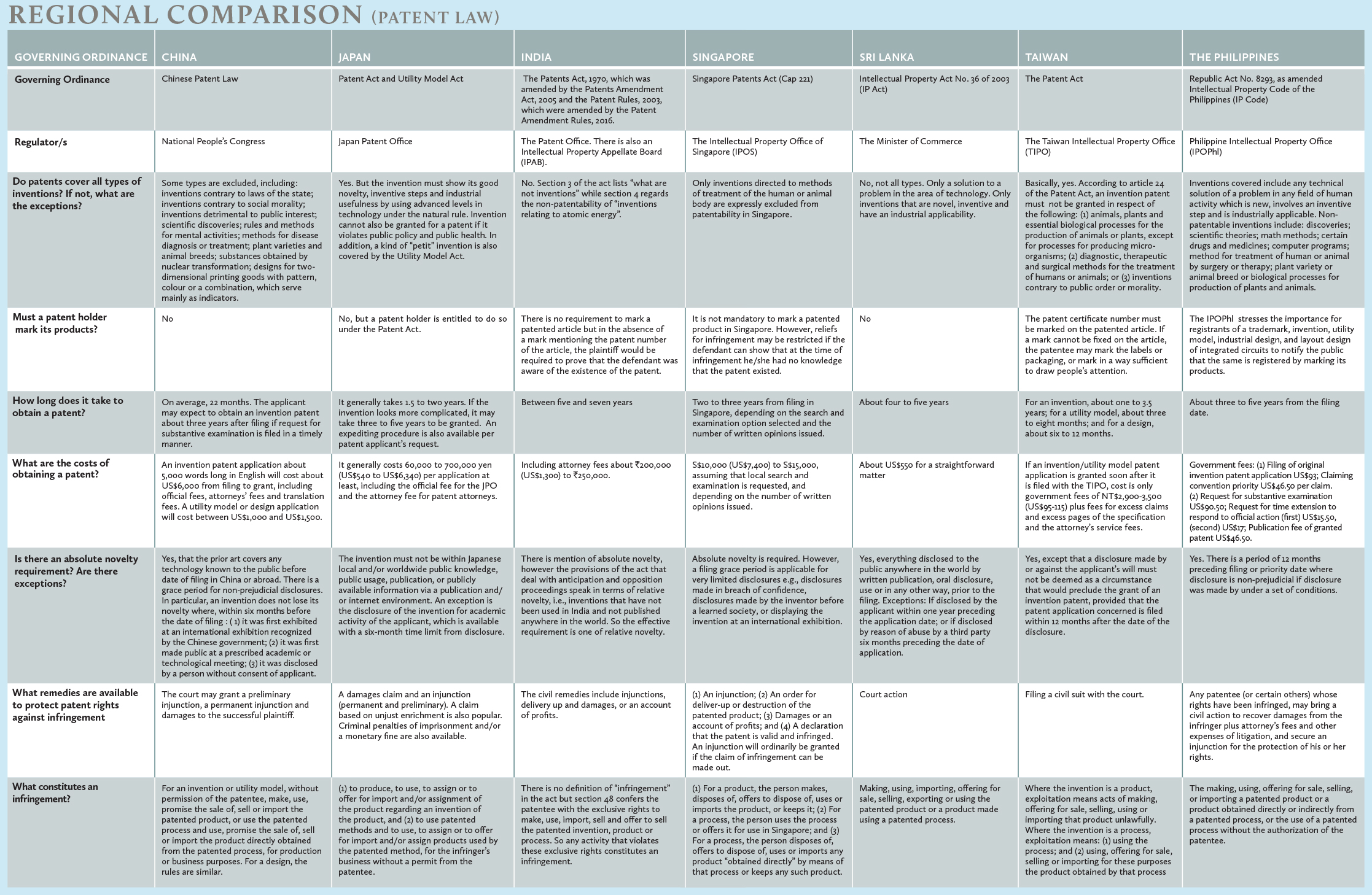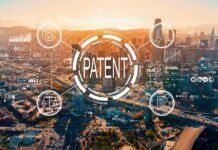Patent laws in the region vary in their effectiveness. Regulations across jurisdictions to crack down on infringers are in a constant state of renewal and revision in order to stay ahead of those who steal intellectual property. Keeping the trolls at bay depends on staying abreast of regional developments in patent law
Navigation: China | India | Japan | Singapore | Sri Lanka | Taiwan | The Philippines
1. Governing ordinance
Chinese Patent Law
Patent Act and Utility Model Act
The Patents Act, 1970, which was amended by the Patents Amendment Act, 2005 and the Patent Rules, 2003, which were amended by the Patent Amendment Rules, 2016.
Singapore Patents Act (Cap 221)
Intellectual Property Act No. 36 of 2003 (IP Act)
The Patent Act
Republic Act No. 8293, as amended Intellectual Property Code of the Philippines (IP Code)
2. Regulator/s
National People’s Congress
Japan Patent Office
The Patent Office. There is also an Intellectual Property Appellate Board (IPAB).
The Intellectual Property Office of Singapore (IPOS)
The Minister of Commerce
The Taiwan Intellectual Property Office (TIPO)
Philippine Intellectual Property Office (IPOPhl)
3. Do patents cover all types of inventions? If not, what are the exceptions?
Some types are excluded, including: inventions contrary to laws of the state; inventions contrary to social morality; inventions detrimental to public interest; scientific discoveries; rules and methods for mental activities; methods for disease diagnosis or treatment; plant varieties and animal breeds; substances obtained by nuclear transformation; designs for twodimensional printing goods with pattern, colour or a combination, which serve mainly as indicators.
Yes. But the invention must show its good novelty, inventive steps and industrial usefulness by using advanced levels in technology under the natural rule. Invention cannot also be granted for a patent if it violates public policy and public health. In addition, a kind of “petit” invention is also covered by the Utility Model Act.
No. Section 3 of the act lists “what are not inventions” while section 4 regards the non-patentability of “inventions relating to atomic energy”.
Only inventions directed to methods of treatment of the human or animal body are expressly excluded from patentability in Singapore.
No, not all types. Only a solution to a problem in the area of technology. Only inventions that are novel, inventive and have an industrial applicability.
Basically, yes. According to article 24 of the Patent Act, an invention patent must not be granted in respect of the following: (1) animals, plants and essential biological processes for the production of animals or plants, except for processes for producing microorganisms; (2) diagnostic, therapeutic and surgical methods for the treatment of humans or animals; or (3) inventions contrary to public order or morality
Inventions covered include any technical solution of a problem in any field of human activity which is new, involves an inventive step and is industrially applicable. Nonpatentable inventions include: discoveries; scientific theories; math methods; certain drugs and medicines; computer programs; method for treatment of human or animal by surgery or therapy; plant variety or animal breed or biological processes for production of plants and animals.
4. Must a patent holder mark its products?
No
No, but a patent holder is entitled to do so under the Patent Act.
There is no requirement to mark a patented article but in the absence of a mark mentioning the patent number of the article, the plaintiff would be required to prove that the defendant was aware of the existence of the patent.
It is not mandatory to mark a patented product in Singapore. However, reliefs for infringement may be restricted if the defendant can show that at the time of infringement he/she had no knowledge that the patent existed.
No
The patent certificate number must be marked on the patented article. If a mark cannot be fixed on the article, the patentee may mark the labels or packaging, or mark in a way sufficient to draw people’s attention.
The IPOPhl stresses the importance for registrants of a trademark, invention, utility model, industrial design, and layout design of integrated circuits to notify the public that the same is registered by marking its products.
You must be a
subscribersubscribersubscribersubscriber
to read this content, please
subscribesubscribesubscribesubscribe
today.
For group subscribers, please click here to access.
Interested in group subscription? Please contact us.
你需要登录去解锁本文内容。欢迎注册账号。如果想阅读月刊所有文章,欢迎成为我们的订阅会员成为我们的订阅会员。
5. How long does it take to obtain a patent?
On average, 22 months. The applicant may expect to obtain an invention patent about three years after filing if request for substantive examination is filed in a timely manner.
It generally takes 1.5 to two years. If the invention looks more complicated, it may take three to five years to be granted. An expediting procedure is also available per patent applicant’s request.
Between five and seven years
Two to three years from filing in Singapore, depending on the search and examination option selected and the number of written opinions issued.
About four to five years
For an invention, about one to 3.5 years; for a utility model, about three to eight months; and for a design, about six to 12 months.
About three to five years from the filing date.
6. What are the costs of obtaining a patent?
An invention patent application about 5,000 words long in English will cost about US$6,000 from filing to grant, including official fees, attorneys’ fees and translation fees. A utility model or design application will cost between US$1,000 and US$1,500.
It generally costs 60,000 to 700,000 yen (US$540 to US$6,340) per application at least, including the official fee for the JPO and the attorney fee for patent attorneys
Including attorney fees about ₹200,000 (US$1,300) to ₹250,000.
S$10,000 (US$7,400) to S$15,000, assuming that local search and examination is requested, and depending on the number of written opinions issued.
About US$550 for a straightforward matter
If an invention/utility model patent application is granted soon after it is filed with the TIPO, cost is only government fees of NT$2,900-3,500 (US$95-115) plus fees for excess claims and excess pages of the specification and the attorney’s service fees.
Government fees: (1) Filing of original invention patent application US$93; Claiming convention priority US$46.50 per claim. (2) Request for substantive examination US$90.50; Request for time extension to respond to official action (first) US$15.50, (second) US$17; Publication fee of granted patent US$46.50.
7. Is there an absolute novelty requirement? Are there exceptions?
Yes, that the prior art covers any technology known to the public before date of filing in China or abroad. There is a grace period for non-prejudicial disclosures. In particular, an invention does not lose its novelty where, within six months before the date of filing : ( 1) it was first exhibited at an international exhibition recognized by the Chinese government; (2) it was first made public at a prescribed academic or technological meeting; (3) it was disclosed by a person without consent of applicant.
The invention must not be within Japanese local and/or worldwide public knowledge, public usage, publication, or publicly available information via a publication and/ or internet environment. An exception is the disclosure of the invention for academic activity of the applicant, which is available with a six-month time limit from disclosure.
There is mention of absolute novelty, however the provisions of the act that deal with anticipation and opposition proceedings speak in terms of relative novelty, i.e., inventions that have not been used in India and not published anywhere in the world. So the effective requirement is one of relative novelty.
Absolute novelty is required. However, a filing grace period is applicable for very limited disclosures e.g., disclosures made in breach of confidence, disclosures made by the inventor before a learned society, or displaying the invention at an international exhibition.
Yes, everything disclosed to the public anywhere in the world by written publication, oral disclosure, use or in any other way, prior to the filing. Exceptions: If disclosed by the applicant within one year preceding the application date; or if disclosed by reason of abuse by a third party six months preceding the date of application
Yes, except that a disclosure made by or against the applicant’s will must not be deemed as a circumstance that would preclude the grant of an invention patent, provided that the patent application concerned is filed within 12 months after the date of the disclosure.
Yes. There is a period of 12 months preceding filing or priority date where disclosure is non-prejudicial if disclosure was made by under a set of conditions.
8. What remedies are available to protect patent rights against infringement?
The court may grant a preliminary injunction, a permanent injunction and damages to the successful plaintiff.
A damages claim and an injunction (permanent and preliminary). A claim based on unjust enrichment is also popular. Criminal penalties of imprisonment and/or a monetary fine are also available.
The civil remedies include injunctions, delivery up and damages, or an account of profits.
(1) An injunction; (2) An order for deliver-up or destruction of the patented product; (3) Damages or an account of profits; and (4) A declaration that the patent is valid and infringed. An injunction will ordinarily be granted if the claim of infringement can be made out.
Court action
Filing a civil suit with the court.
Any patentee (or certain others) whose rights have been infringed, may bring a civil action to recover damages from the infringer plus attorney’s fees and other expenses of litigation, and secure an injunction for the protection of his or her rights.
9. What constitutes an infringement?
For an invention or utility model, without permission of the patentee, make, use, promise the sale of, sell or import the patented product, or use the patented process and use, promise the sale of, sell or import the product directly obtained from the patented process, for production or business purposes. For a design, the rules are similar.
(1) to produce, to use, to assign or to offer for import and/or assignment of the product regarding an invention of the product, and (2) to use patented methods and to use, to assign or to offer for import and/or assign products used by the patented method, for the infringer’s business without a permit from the patentee
There is no definition of “infringement” in the act but section 48 confers the patentee with the exclusive rights to make, use, import, sell and offer to sell the patented invention, product or process. So any activity that violates these exclusive rights constitutes an infringement.
(1) For a product, the person makes, disposes of, offers to dispose of, uses or imports the product, or keeps it; (2) For a process, the person uses the process or offers it for use in Singapore; and (3) For a process, the person disposes of, offers to dispose of, uses or imports any product “obtained directly” by means of that process or keeps any such product.
Making, using, importing, offering for sale, selling, exporting or using the patented product or a product made using a patented process.
Where the invention is a product, exploitation means acts of making, offering for sale, selling, using or importing that product unlawfully. Where the invention is a process, exploitation means: (1) using the process; and (2) using, offering for sale, selling or importing for these purposes the product obtained by that process
The making, using, offering for sale, selling, or importing a patented product or a product obtained directly or indirectly from a patented process, or the use of a patented process without the authorization of the patentee.
[/ihc-hide-content]



























